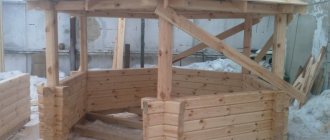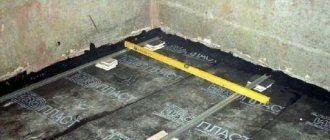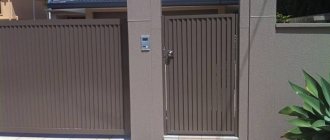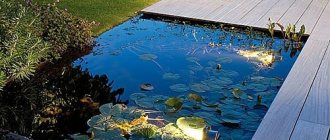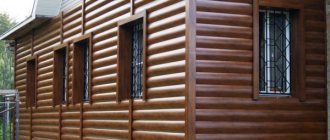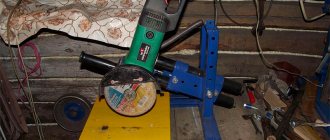It is no exaggeration to say that every summer resident wants to have his own swimming pool. Unfortunately, luxurious, expensive buildings, like those that flaunt on Hollywood photos and videos, are an unattainable dream for most owners of a modest six hundred square meters, however, if you moderate your ambitions, then for relatively little money you can equip your dacha with a nice small-sized plastic pool-greenhouse . Judging by the reviews on various dacha forums, a polycarbonate-covered pool is easy to install with your own hands and lasts at least 10 years.
Pros and cons of a swimming pool at the dacha in a greenhouse
The popularity of garden pools in greenhouses is due to a combination of many positive aspects. Among the key advantages of this solution are:
- Possibility of using the pool all year round, regardless of weather conditions. If in the summer the water in the pool is heated by the sun's rays freely penetrating into the structure through the polycarbonate, then in the winter the pool in the greenhouse needs heating elements that will maintain normal water temperature.
- Due to the fact that the pool at the dacha in the greenhouse is located under the roof, users will be reliably protected from the harmful effects of ultraviolet radiation. This is especially good for people who cannot stay under the sun for a long time due to certain circumstances.
- There will be virtually no debris getting into the water. Since the greenhouse is closed on all sides, the water will remain clean for a long time. At the same time, the greenhouse can be equipped with windows and vents with mosquito nets. This way the issue of ventilation of the room will be resolved. In addition, this way the water is protected from various pathogenic microorganisms and bacteria.
- Neat and aesthetic appearance. The pool will fit perfectly into the landscape of any site and will become the “highlight” of the dacha. At the same time, outwardly it will not be any different from classic greenhouses for growing vegetables, so there will be no dissonance of perception.
- Reduced water heating costs. Classic outdoor pools require constant water heating. Due to the fact that air has free access to such reservoirs, the water in them quickly cools down even in summer weather. In closed reservoirs in a greenhouse, heating will occur due to sunlight, and the water cools much more slowly due to polycarbonate, and in winter, heaters will be required.
- Simple and affordable installation. You can install a frame pool in a polycarbonate greenhouse yourself. The procedure does not involve any special problems. The main thing is to have at least basic knowledge in the construction industry in order to make a pool in a greenhouse with your own hands.
- The water in the pool will practically not evaporate, so you won’t have to constantly add it. At the same time, the humidity level in a polycarbonate pool greenhouse will be maintained at a normal level all year round if it is ventilated periodically.
In addition to the advantages of pools in greenhouses, there are some disadvantages that should be considered:
- Due to the limited access of oxygen to the greenhouse, the water may begin to bloom over time. An unpleasant odor will also appear. To avoid this, you will need to install a filter system and think about the issue of regular ventilation of the room.
- To build a permanent canopy for a children's pool in a greenhouse, you will need to build a reliable and durable foundation. If this is not done, the structure may gradually deform.
- To organize a good protective canopy, water filtration and other important aspects, you will have to spend a fairly large amount of money. However, when compared with the construction of a classic outdoor pool, the level of costs will be disproportionately lower.
- Difficulties may arise with draining and replacing water. To avoid this, you will have to install several drains and bring the water source as close as possible.
The procedure for performing construction work
To equip a greenhouse pool, you will need “water” plastic pipes and fittings, pipes for laying the cable and the cable itself, waterproof lamps, circulation sediment and a skimmer (a device for filtering water)
Building a greenhouse yourself “from scratch” is a thankless and economically unprofitable task. Profiled pipes, screws, silicone washers and polycarbonate sheets purchased separately (and, as a rule, with a reserve) are much more expensive in total than a ready-made factory design. Carrying out all the calculations and making a drawing of the building is not easy. In addition, without experience, it is not always possible to correctly mark and cut out the details of a structure; it can be especially difficult to make its doors and windows. Therefore, a homemade greenhouse, assembled with great difficulty, often looks mowed and does not look aesthetically pleasing.
In order not to have to worry about marking the mounting holes and adjusting the plastic panels, it is better to buy a set of elements for making a greenhouse (or order it at the factory), and just mount them yourself and install the greenhouse on a pre-filled strip foundation.
You can install a ready-made frame pool in the greenhouse
Types of pools in a polycarbonate greenhouse
In structures of this type, the main element is a pond. However, the protective canopy itself is also of utmost importance:
- Aesthetic design of the pool. The pavilion should have a neat appearance, fit the overall style of the summer cottage, complementing and decorating it.
- Protecting the tank from contamination. One of the main purposes of a greenhouse is to prevent various debris and harmful microorganisms from entering the water.
- Decorative camouflage. For maximum comfort, it is necessary that the canopy hides what is happening inside. That is why builders recommend using polycarbonate as a coating. From the outside, it distorts the image, making it incredibly difficult to see what is happening in the center of the greenhouse.
- Neutralization of dangerous ultraviolet radiation.
The shape of the greenhouse directly depends on the type of pool. They are classified according to form:
- combined. Models of this type are a combination of several classic styles. Often such pools are a vast space in which, in addition to the reservoir, there are several functional recreation areas (for example, a gazebo with a pool in a greenhouse);
- arched This format is considered the most popular. There will be no difficulties during installation, since polycarbonate bends well. Due to the fact that the roof of the greenhouse has several slopes, snow will not accumulate on it in winter;
- domed. This type is ideal for a round pool. This design is incredibly complex to implement and requires great construction skills and materials. This is why users often choose rectangular frame pools in a greenhouse;
- pitched. The simplest option, in which the canopy for the font will have smooth walls. The only caveat is that this design is not very stable, therefore it is not recommended in regions with strong winds.
Important! To optimize construction and increase structural strength, it is necessary to equip the greenhouse with special guide rollers and seals. The sliding roof and doors will significantly reduce the cost of building the complex.
Feeding seedlings
If we have good soil, then fertilizing can be done only as needed. If we see that the plant is very pale, then this will tell us about a lack of nitrogen. You can use nitrogen fertilizers (urea, ammonium nitrate), but it is better to use a small concentration of fertilizer when watering, water not just with water, but with a small content of nutrients, based on a teaspoon of complex mineral fertilizer per 1 liter of water. Tomatoes are very responsive to phosphorus and potassium, so it is necessary to periodically extract superphosphate and fertilize with only phosphorus.
How to make a swimming pool in a polycarbonate greenhouse with your own hands
Reviews about the swimming pool at the dacha in the greenhouse from users are always mostly positive. The installation of a pool in a greenhouse is carried out in two stages. Initially, the user will have to start arranging a pit for the pool, after which he can proceed to the construction of a protective canopy.
To arrange a pool bowl, you need to follow the algorithm:
- In the required location, a pit is dug for the pool bowl and separate trenches for pipes.
- A large amount of sand is poured into the bottom of the pit, which will act as an absorbent, purifying the incoming water from various impurities. After this, it is necessary to weld a steel frame from reinforcement, which is sheathed on the outside with wooden boards.
- After installing the frame, installation of the polymer pool bowl begins. If there is free space between it and the frame, you need to get rid of it with sand. This will fix the bowl, making it motionless. After this operation has been completed in full, you can begin installing the sides and stairs.
- At the final stage, pipes are laid, they are connected and all connections are sealed.
- Once the pool bowl is completely ready, you can proceed to installing the protective canopy. However, before this, the bowl should be covered with durable and dense material to prevent various construction debris from entering the pool.
The construction of a greenhouse around the pool occurs according to the following regulations:
- The first step is to dig a trench under the strip foundation and install the formwork. Next, a metal frame is made, which is placed in the trench.
- The next step is preparing the mortar and pouring it. It takes about two weeks for concrete to completely harden. At the same time, it must be constantly moistened with water so that the adhesion is as strong as possible.
- After pouring the concrete, you need to install the vertical frame posts. Once the foundation is completely ready, the transverse parts begin to be attached to them. After preparing the “skeleton” of the future greenhouse, a sealing tape is attached to it, after which they begin to install the polycarbonate slabs.
- Transparent polycarbonate is fixed to a metal frame using stainless steel self-tapping screws and silicone thermal washers. The end parts of the polycarbonate are sealed with special tapes and aluminum profiles.
Construction site
When you decide to build a greenhouse pool, first of all find a suitable place for it. Ideally, the site intended for the construction of such a structure should be:
- extensive and located as close as possible to technical communications;
- not surrounded by trees, whose roots will interfere with the digging of a pit, and whose branches will interfere with the construction of the pavilion;
- level relative to the horizon, i.e. not located on a slope;
- with dense clay soil that will not sag under the weight of the pool bowl.
To build a pool you need a place with dense soil
Operation and Maintenance
Polycarbonate is an unpretentious material, so maintaining a greenhouse under a pool is not a complicated procedure. However, given the fact that this material may fade over time and lose its visual appeal, you need to know some rules of care:
- It is advisable to make the frame from stainless steel and other metals that are protected from corrosion. If the base is made of wood, it is necessary to carry out regular checks, as mold may form and signs of wetting will appear. All this will negatively affect the operational parameters of the structure.
- To minimize the appearance of rust, all metal elements must be painted with special protective paints.
- Despite the fact that polycarbonate is resistant to external influences, dust accumulations can form on it. If you ignore them, the material will lose its attractive appearance and indelible stains will form on it. To prevent this, you need to regularly carry out wet cleaning using any type of detergent.
- To prevent the water from stagnating and creating an unpleasant aroma, it must be changed periodically. To do this, water is completely released from the pit. It is recommended to wash the polymer bowl using detergents, after which the pool can be refilled with water.
To combine a greenhouse with a swimming pool and use the pavilion all year round, you need to think about installing additional protective systems. In winter, water can be heated exclusively from installed heating elements. The polycarbonate pavilion itself must have the maximum degree of sealing, which will allow it to be used at any time of the year.
Some experts recommend placing the pool in a greenhouse and digging the base of the pavilion slightly into the ground. Thanks to this, the canopy will absorb the heat of the ground, and the roofing will prevent it from leaving the room. However, this is only relevant in regions where winters are mild without prolonged severe frosts.
If the pool is installed in a country house in a cold region, it is necessary to take care of organizing internal heating in advance.
Construction requirements
- The pool bowl is protected in different ways. The canopy covers the pond on one side or on several. Often a full-fledged pavilion is built - the most reliable shelter.
- The covering can be either stationary or sliding (telescopic). The latter is quickly transformed: this is its big advantage, but it is quite difficult to manufacture. This is a minus.
- The type of swimming bowl determines the shape of the pool itself. It can be rectangular, combined, or round.
The polycarbonate pavilion itself, built over a country pool and made with your own hands, comes in different shapes :
- Asymmetric. Reminds me of a semi-arch. It has a vertical wall along the building plus a vault on its opposite side. The vertical end walls act as a place for mounting the door. This option makes the structure voluminous, able to accommodate a recreation area.
- Pavilion in the form of a dome. It is installed if the reservoir bowl is round in shape. If you build it yourself, the polycarbonate will have to be cut into segments. But the structure turns out to be spectacular and aesthetically pleasing.
- The arched and pitched pavilions have two longitudinal vertical walls. Building them yourself is quite simple.
Photo of swimming pools in a polycarbonate greenhouse
Cleaning equipment
It must be foreseen in advance. For pools constructed independently from ready-made bowls, there are 2 options for filtration systems.
- Skimmer. This device, which literally means “skimmer” or “water cutter”, first cleans the surface of the water. Then the liquid is purified in a filter unit, heated, and chemically treated. Then it, crystal clear, returns to the bowl again.
- Overflow. In this case, the water pouring overboard during swimming is collected in overflow gutters, which are located along the sides of the bowl. From there it goes to the lower container, where the water is heated, filtered, completely purified, and then returned to its rightful place.
Skimmer filtration is effective, simple, and affordable. Overflow pools are synonymous with a constant water level, since it does not depend on the number of “ichthyanders” splashing simultaneously in the bowl. They do have some disadvantages: the high cost of the equipment and the complexity of maintenance.

